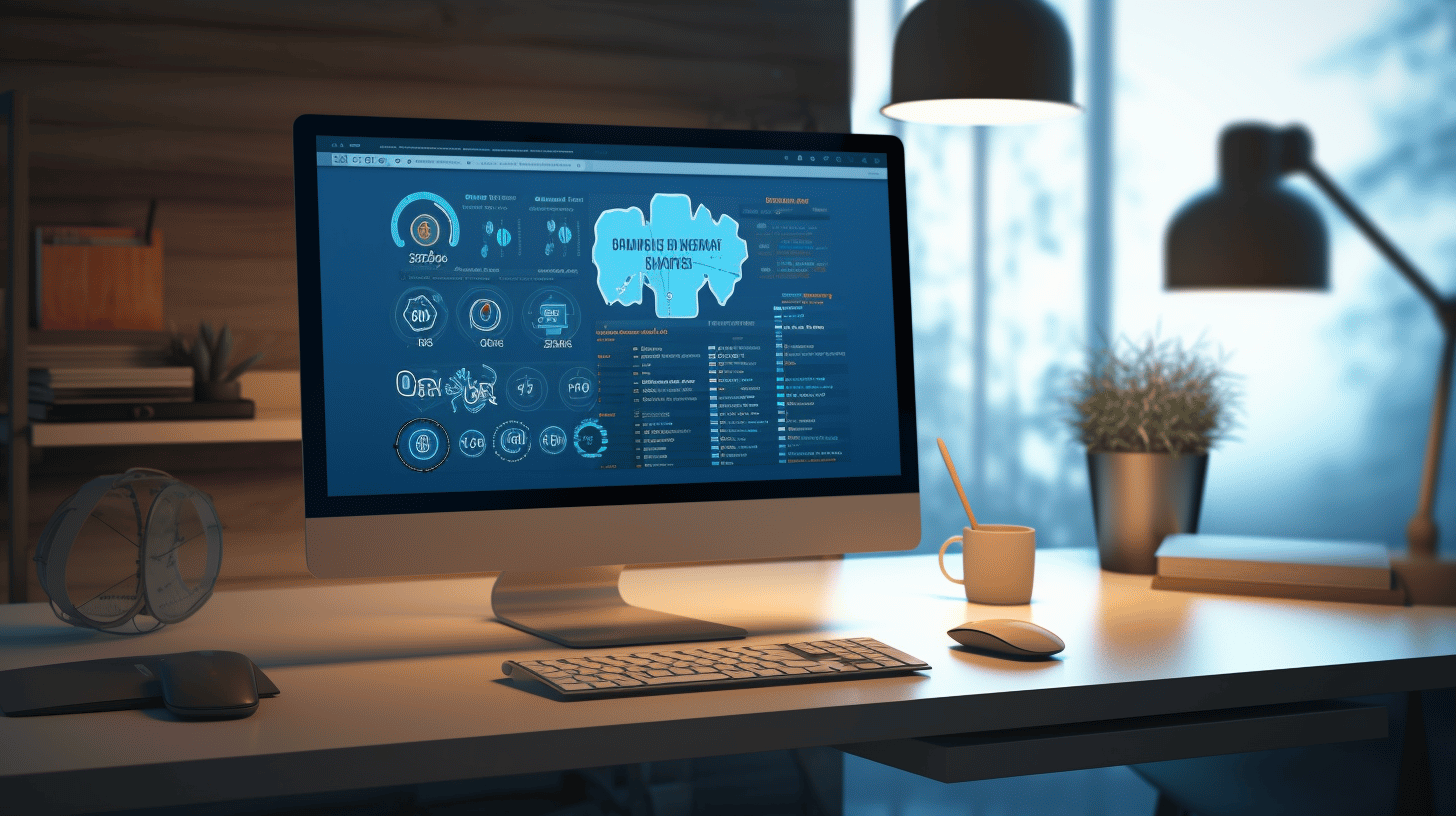您準備好將您的網站管理技能提升到更高的水平了嗎?無論您是想要建立第一個網站的新手,還是想要增強現有 WordPress 網站的經驗豐富的網站管理員,本文都適合您。在當今的數位環境中,對於任何想要在線上展示的人來說,擁有管理 WordPress 網站的技能都是必不可少的。從小型企業到部落客再到線上商店,WordPress 是建立和管理網站的首選平台。在本綜合指南中,我們將引導您了解成為熟練的 WordPress 管理員所需的基本技能。
🚀 所以,繫好安全帶,準備進入 WordPress 的世界,釋放您的網站管理潛力。讀完本文後,您將掌握創建、自訂、優化和維護令人驚嘆的 WordPress 網站的知識和工具。無論您是初學者還是經驗豐富的網站管理員,這裡都能滿足您的需求。
了解 WordPress 基礎知識
🌟 介紹
所以您決定創建一個網站,並且您聽說過這個叫 WordPress 的東西。但是 WordPress 到底是什麼,它如何幫助您建立成功的線上形象?在本節中,我們將探索 WordPress 的基礎知識,從其元件到如何建立 WordPress 帳戶。讓我們開始吧!
網站組件
在我們了解 WordPress 之前,讓我們先了解構成網站的各種元件。這些組件包括:
- 📌 網域:網域名稱是您的網站在網路上的位址(例如,www.example.com)。它就像您的網上家園的實際地址。
- 📌 虛擬主機:網站託管是允許您的網站在互聯網上存取的服務。它就像您建立網站的土地一樣。選擇可靠的網站寄存服務提供者對於您網站的效能和安全性至關重要。
- 📌 內容管理系統(CMS):CMS 是一種軟體,讓您無需任何編碼知識即可建立、編輯和管理網站內容。 WordPress 是最受歡迎且用戶友好的 CMS 平台之一。
- 📌 主題:主題決定您網站的整體設計和佈局。他們提供預先設計的模板,您可以根據您的品牌和風格進行客製化。
- 📌 插件:插件就像您網站的應用程式。它們擴展了您的 WordPress 網站的功能並允許您添加聯絡表單、社交媒體整合和 SEO 優化等功能。
WordPress 簡介
🌱WordPress 是一個免費的開源內容管理系統,為網路上超過 40% 的網站提供支援。以下是有關 WordPress 的一些要點:
- 📌 方便使用的:WordPress 以其用戶友好的介面而聞名,即使非技術用戶也可以使用。您無需成為程式設計專家即可使用 WordPress 建立令人驚嘆的網站。
- 📌 可客製化:WordPress 擁有數千種主題和插件,可提供無限的自訂選項。無論您正在建立個人部落格還是電子商務商店,WordPress 都能適應您的需求。
- 📌 SEO友善:WordPress 開箱即用,對 SEO 友好,這意味著它針對搜尋引擎進行了優化。這使您的網站更有機會在搜尋引擎結果中排名更高,從而為您的網站帶來更多自然流量。
- 📌 活躍社群:WordPress 擁有龐大而活躍的開發者和用戶社區,他們為其發展做出貢獻並提供支援。如果您遇到問題,可以向社群論壇尋求協助或聘請開發人員。
建立 WordPress 帳戶
🎉 準備好開始了嗎?建立 WordPress 帳戶是一個簡單的過程:
- 📌 步驟 1:造訪 WordPress 官方網站 wordpress 論壇 並點擊“開始”按鈕。
- 📌 步驟2:為您的網站選擇域名,如果您已經有域名,請使用現有域名。您也可以選擇在 WordPress.com 上託管您的網站或使用 WordPress.org 自行託管。
- 📌 步驟3:按照提示輸入您的帳戶訊息,包括您的電子郵件地址、使用者名稱和密碼。請務必選擇一個強密碼來確保您的網站安全。
- 📌 步驟4:建立帳戶後,您可以登入 WordPress 儀表板,在那裡您可以完全控制網站的內容、設計和功能。
🌟 現在您對 WordPress 的基礎知識有了更好的了解,您可以開始建立您的網站了。在下一節中,我們將探討如何 管理您的 WordPress 網站 有效確保其成功。敬請關注!
注意:有關管理 WordPress 網站的提示和技巧,請查看此 有用的資源.
選擇與自訂 WordPress 主題
📚 介紹
當要創建一個視覺上有吸引力且用戶友好的網站時,選擇和自訂 WordPress 主題是關鍵。有數千個主題可供選擇,找到符合您的品牌、吸引受眾並提供無縫瀏覽體驗的正確主題至關重要。在本文中,我們將探討選擇完美 WordPress 主題的過程以及如何自訂它以滿足您的獨特需求。
選擇正確的主題
🔎 尋找你的完美伴侶
由於有這麼多種類的 WordPress 主題可供選擇,縮小選擇範圍可能會很困難。以下一些技巧可幫助您為網站選擇正確的主題:
- 確定您的網站的目的: 考慮您的網站的主要目的。它是個人部落格、電子商務商店、作品集還是商業網站?了解您網站的用途將幫助您確定您需要的功能和設計元素類型。
- 考慮你的品牌: 您的網站應該體現您的品牌特徵。尋找具有可自訂功能(如配色方案、字體和佈局)的主題。這樣,您可以確保主題符合您的品牌美學並傳達您的獨特風格。
- 評估使用者體驗: 好的主題是優先考慮使用者體驗的主題。確保主題易於導航、可在不同裝置上回應且載入迅速。積極的用戶體驗將使訪客保持參與並再次訪問。
- 閱讀用戶評論: 不要僅僅依賴主題的外觀。要評估其品質和功能,請閱讀用戶評論和評分。這將讓您深入了解主題的效能、客戶支援以及與外掛程式的兼容性。
🧑💻 自訂 WordPress 主題
雖然找到正確的主題至關重要,但根據您的喜好和品牌標誌進行客製化也同樣重要。以下提示可協助您開始自訂 WordPress 主題:
- 自訂顏色和字體: 大多數 WordPress 主題都提供更改顏色和字體以符合您的品牌的選項。嘗試不同的組合,直到找到讓您的網站充滿活力的完美平衡。
- 新增自訂小工具: 小部件是增強網站功能的好方法。您可以添加用於社交媒體整合、電子郵件訂閱、熱門貼文等的小工具。這些額外的功能可以幫助提高用戶參與度並使您的網站更具互動性。
- 配置主題設定: 大多數 WordPress 主題都帶有自己的設定面板,讓您可以配置主題的各個方面。這可以包括自訂頁首和頁尾、選擇佈局或設定自訂主頁。
- 使用頁面建立器: 頁面建立器是功能強大的工具,可讓您無需任何編碼知識即可建立自訂頁面佈局。它們提供了拖放介面,讓您可以輕鬆排列元素並自訂網站的設計。
📱 響應式網頁設計
在當今以行動為中心的世界裡,擁有一個在所有裝置上都看起來很棒的響應式網站至關重要。響應式網頁設計可確保您的網站能夠在智慧型手機、平板電腦和桌上型電腦上正確適應和顯示。選擇 WordPress 主題時,請尋找那些專門標記為「響應式」的主題。這些主題將根據螢幕尺寸自動調整其佈局和設計,在所有裝置上提供一致的使用者體驗。
📝 結論
選擇符合您願景的 WordPress 主題並自訂以符合您的品牌是建立引人入勝的網站的關鍵步驟。透過考慮您網站的目的、評估使用者體驗和自訂其元素,您可以創建視覺上令人驚嘆且具有互動性的線上形象。請記住,正確的主題可以吸引觀眾並留下持久的印象。所以,繼續吧,探索廣闊的 WordPress 主題世界,找到最符合您需求的主題。
WordPress 外掛:使用與管理
WordPress 外掛是建立和管理成功網站的重要組成部分。它們提供廣泛的功能和特性,可以增強您網站的效能、安全性和使用者體驗。無論您是初學者還是經驗豐富的 WordPress 用戶,了解外掛程式的重要性以及如何安裝和管理外掛程式對於創建一個脫穎而出的網站至關重要。
插件的重要性
外掛程式在擴展 WordPress 網站的功能方面發揮著至關重要的作用。它們允許您添加新功能、自訂網站外觀、優化搜尋引擎等等。以下是插件很重要的幾個原因:
- 增強功能: 外掛程式為您的網站添加新的功能和能力,例如聯絡表單、社交媒體整合、電子商務功能、SEO 優化等。這些功能可協助您創建獨特且引人入勝的使用者體驗。
- 改進的性能: 一些外掛程式旨在優化您的網站的速度和效能。它們可以幫助您快取網頁、壓縮圖片、縮小 CSS 和 JavaScript 檔案以及執行其他效能優化,從而加快載入時間。
- 增強安全性: 安全是任何網站所有者最關心的問題。 WordPress 外掛程式可以透過新增防火牆保護、實施雙重認證、阻止惡意 IP 位址和掃描惡意軟體來幫助您加強網站的安全性。
- 客製化: 外掛程式可讓您自訂您的網站,而無需高級編碼知識。使用正確的插件,您可以輕鬆更改網站的外觀、佈局和功能以滿足您的獨特要求。
- 搜尋引擎優化: 搜尋引擎優化 (SEO) 對於提高您的網站在搜尋引擎結果中的可見度至關重要。 Yoast SEO 或 All in One SEO Pack 等外掛程式提供了強大的工具來幫助您優化內容、元標籤、網站地圖等,讓搜尋引擎更容易發現和排名您的網站。
頂級 WordPress 插件
在為您的 WordPress 網站選擇外掛程式時,有成千上萬種可供選擇的外掛程式。找到適合您的特定需求的產品可能會很困難。以下是一些您應該考慮的流行且值得信賴的 WordPress 外掛:
- 值得信賴的 WordPress 插件:此綜合清單精選了不同類別的最佳 WordPress 外掛程式。從安全性到效能到 SEO,您會找到經過測試並證明可靠的插件推薦。
- 噴射背包: Jetpack 由 WordPress 背後的公司 Automattic 開發,提供了一系列強大的功能,包括安全性、效能優化、網站分析、社群媒體整合等。
- WooCommerce: 如果您想建立一家線上商店,WooCommerce 是一個不錯的選擇。它使您能夠銷售實體和數位產品、管理庫存、處理付款以及客製化您的商店以匹配您的品牌。
- 聯絡表格 7: 該外掛程式可讓您輕鬆地在您的網站上建立和管理聯絡表單。它支援多種形式、可自訂欄位和垃圾郵件防護,使其成為捕獲用戶查詢的首選解決方案。
- 酵母SEO: Yoast SEO 是優化您網站 SEO 的必備外掛。它提供了一個直覺的介面來優化您的內容、生成 XML 網站地圖、添加元標記以及分析您網站的 SEO 效能。
安裝和管理插件
在 WordPress 中安裝和管理外掛是一個簡單的過程。以下是逐步指南:
- 登入您的 WordPress 管理儀表板。
- 導航至“插件”部分並點擊“新增”。
- 依名稱或功能搜尋所需的插件。
- 點擊要安裝的插件旁邊的“立即安裝”按鈕。
- 安裝完成後,按一下「啟動」按鈕即可在您的網站上啟用該外掛程式。
- 要管理您的插件,請前往儀表板中的“插件”部分。在這裡,您可以根據需要停用、啟用或刪除外掛程式。
請記住定期更新您的插件,以確保與最新版本的 WordPress 相容並接收安全性修補程式和功能更新。
總而言之,WordPress 外掛程式是增強您網站的功能、安全性和使用者體驗的寶貴工具。透過了解外掛程式的重要性以及如何有效地安裝和管理它們,您將能夠利用這些強大的工具來創建一個真正脫穎而出的網站。
WordPress 中的內容管理
內容管理是經營成功網站的關鍵部分,WordPress 讓創建、編輯和組織內容變得比以往更簡單。無論您是經驗豐富的部落客還是剛起步,WordPress 都提供了用戶友好的介面和一系列功能,讓您能夠有效地管理內容。
使用WordPress編輯器
WordPress 中最強大的工具之一是內建編輯器,它允許您輕鬆建立和格式化您的內容。以下是 WordPress 編輯器一些主要功能的細分:
- 文字格式:您可以使用各種選項來設定文字格式,例如粗體、斜體、底線和刪除線。這些格式選項可幫助您強調重點並使您的內容更具視覺吸引力。
- 標題:除了基本格式之外,WordPress 還提供不同的標題樣式,從標題 1 到標題 6。
- 清單:WordPress 可讓您輕鬆建立項目符號清單和編號清單。清單有助於將資訊分解為易於理解的部分,並提高內容的整體可讀性。
- 連結:超連結是內容管理的重要方面,WordPress 可以輕鬆插入內部和外部連結。您也可以自訂錨文本,即連結顯示的文本。
發布部落格和頁面
WordPress 擅長管理不同類型的內容,無論是部落格文章還是靜態頁面。讓我們仔細看看如何在 WordPress 中發布部落格和頁面:
- 部落格:部落格文章通常用於發布新聞、文章和其他時間敏感的內容。使用 WordPress,您可以輕鬆添加新的部落格文章、對其進行分類、標記以便於搜索,並安排它們以供將來發布。
- 頁數:另一方面,靜態頁面非常適合創建常青內容,例如「關於我們」或「聯絡我們」頁面。 WordPress 可讓您輕鬆建立和組織頁面,並提供不需要任何技術知識的使用者友善介面。
利用 WordPress 媒體庫
視覺內容在吸引網站訪客方面起著至關重要的作用,WordPress 提供了廣泛的媒體庫來管理您的圖像、影片和其他媒體檔案。充分利用 WordPress 媒體庫的方法如下:
- 上傳媒體:您可以輕鬆地將圖像和影片直接從電腦上傳到媒體庫。 WordPress 支援多種文件格式,可輕鬆將媒體新增至您的網站。
- 組織和搜尋:WordPress 提供將您的媒體檔案組織到資料夾和子資料夾中的功能,以便於導航。此外,您還可以為媒體檔案新增元資料和標籤,以便更輕鬆地透過搜尋功能找到它們。
- 插入媒體:上傳媒體檔案後,您可以輕鬆地將其插入到您的部落格文章或頁面中。 WordPress 提供了方便的格式化選項,用於調整媒體的大小、對齊和添加標題,確保它們無縫地融入您的內容。
有效管理您的內容是維護一個充滿活力和吸引力的網站的關鍵,而 WordPress 提供了您進行內容管理所需的所有工具。從強大的編輯器到部落格和頁面的無縫發布,以及強大的媒體庫,WordPress 讓任何人都可以輕鬆創建和管理引人入勝的內容。因此,開始探索 WordPress 並將您的內容管理提升到新的水平! 🚀
WordPress SEO 最佳實踐
介紹
在當今數位時代,擁有一個在搜尋引擎結果中排名靠前的網站對於成功至關重要。對於 WordPress 用戶來說,實施有效的 SEO(搜尋引擎優化)實踐可以顯著提高線上可見性並為他們的網站帶來更多流量。無論您是經驗豐富的 WordPress 用戶還是剛開始使用,了解和利用 SEO 最佳實踐都將幫助您實現線上目標。在本文中,我們將探討 SEO 的基礎知識,介紹 WordPress 的熱門 SEO 插件,並提供優化內容以提高搜尋引擎排名的技巧。
了解搜尋引擎優化
SEO 可能是一個複雜且不斷發展的領域,但其核心是讓您的網站更容易被 Google 等搜尋引擎看到。透過優化您的網站和內容,當用戶搜尋相關關鍵字時,您可以增加在搜尋引擎結果中排名更高的機會。知名度的提高可以為您的企業帶來更多的自然流量和潛在客戶。
為了更好地理解SEO,讓我們將其分解為主要組成部分:
- 關鍵字:這些是使用者在尋找資訊時輸入到搜尋引擎的單字或短語。將相關的關鍵字納入您的網站內容有助於搜尋引擎了解您的網站內容,並提高這些關鍵字排名更高的機會。進行徹底的關鍵字研究是任何 SEO 策略中必不可少的一步。
- 頁面優化:頁面優化涉及優化單一網頁以提高其在搜尋引擎結果頁面(SERP)上的可見性。這包括優化內容中的標題標籤、元描述、標題、URL 結構和關鍵字使用。透過遵循頁面優化最佳實踐,您可以讓搜尋引擎更輕鬆地理解和索引您的內容。
- 反向連結:反向連結是從其他網站到您的網站的連結。當信譽良好的網站連結到您的網頁時,搜尋引擎會認為您的網站更具權威性和可信賴性。建立高品質的反向連結是站外 SEO 的一個重要方面,它可以極大地影響您網站的排名。
WordPress 的 SEO 插件
幸運的是,WordPress 提供了各種插件,可以幫助簡化實施 SEO 最佳實踐的過程。這些外掛程式提供了強大的工具和功能,使您無需大量技術知識即可優化您的網站和內容。以下是一些流行的 WordPress SEO 外掛:
| 插件名稱 | 功能 |
|---|---|
| 優斯特蒐尋引擎優化 |
|
| 多合一 SEO 包 |
|
| 排名數學 |
|
這些外掛程式提供一系列功能來幫助您優化您的網站並確保它符合 SEO 最佳實踐。探索這些插件並選擇最適合您需求和偏好的插件。
優化 SEO 內容
對 SEO 來說,內容為王。創建高品質、相關且優化的內容對於提高您的網站在搜尋引擎排名中的可見度至關重要。以下是針對 SEO 優化內容的一些技巧:
- 研究並使用相關關鍵字:進行徹底的關鍵字研究,以確定目標受眾正在搜尋的單字和短語。將這些關鍵字自然地融入您的內容中,以提高其與搜尋引擎的相關性和可見性。
- 創建有價值且引人入勝的內容:專注於創作能為您的受眾提供價值的內容。引人入勝且資訊豐富的內容更有可能被分享和鏈接,這可以促進您網站的 SEO 效果。
- 優化標題和副標題:使用描述性和富含關鍵字的標題和副標題來建立您的內容。這有助於搜尋引擎了解您頁面上資訊的層次和相關性。
- 包括內部和外部鏈接:連結到您網站內的其他相關頁面,以幫助搜尋引擎了解您的內容之間的關係。此外,還包括指向信譽良好的來源的外部鏈接,為您的內容提供額外的背景資訊和可信度。
- 優化您的影像:為您的圖片使用描述性檔案名稱和 alt 標籤,因為搜尋引擎在對您的網頁進行排名時也會考慮它們。優化的圖像可以提高您的網站在搜尋結果中的可見性,尤其是在圖像搜尋中。
透過實施這些內容優化策略,您可以提高網站的可見性,並最終吸引更多自然流量到您的 WordPress 網站。
總而言之,了解 SEO 的基礎知識並實施最佳實踐可以對您的 WordPress 網站的可見性和成功產生重大影響。透過利用 SEO 外掛程式、優化您的內容並隨時了解最新的行業趨勢,您可以保持競爭優勢並增加接觸更廣泛線上受眾的機會。將這些策略納入您的 WordPress SEO 工作中,並觀察您的網站在搜尋引擎排名中的上升。
網站維護和安全
在當今的數位環境中,維護和保護您的網站至關重要。忽視日常維護和忽視安全措施可能會導致您的網站容易受到網路攻擊、停機和寶貴資料的潛在遺失。在本節中,我們將探討網站維護和安全的基本面,特別關注 WordPress。
日常 WordPress 維護
定期維護對於確保您的 WordPress 網站順利運作且保持安全至關重要。以下是您的網站維護清單中應包含的一些常規任務:
- 更新 WordPress 核心: 保持 WordPress 核心更新對於解決任何安全漏洞和從最新的功能和改進中受益至關重要。
- 外掛和主題更新: 定期更新您的外掛程式和主題以修補任何安全漏洞並確保與最新的 WordPress 版本相容。
- 定期備份: 定期備份您的網站以防止資料遺失。這可確保您在發生任何事故時能夠快速恢復您的網站。
- 資料庫優化: 透過優化 WordPress 資料庫,可以刪除不必要的數據,從而提高網站的效能和速度。
WordPress 安全要點
保護您的 WordPress 網站對於防止未經授權的存取、惡意軟體和其他安全威脅至關重要。以下是您應該實施的一些安全要點:
- 強密碼: 為您的 WordPress 管理員帳戶以及與您的網站關聯的任何其他使用者帳戶使用獨特且強大的密碼。避免使用常用密碼,並考慮使用密碼管理器來安全地儲存您的登入憑證。
- 雙重認證(2FA): 啟用 2FA 為您的 WordPress 登入程序新增額外的安全層。這要求使用者除了密碼之外,還提供第二種形式的身份驗證,例如由行動應用程式產生的程式碼。
- 檔案權限: 為您的 WordPress 檔案和目錄設定適當的檔案權限以限制未經授權的存取。
- Web 應用程式防火牆 (WAF): 實施 WAF 可以透過過濾可疑流量和阻止已知的安全威脅來幫助保護您的 WordPress 網站免受惡意攻擊。
處理 WordPress 更新
WordPress 定期發布更新以解決安全漏洞、提高效能並引入新功能。有效地處理這些更新至關重要。以下是一些最佳做法:
- 更新前備份: 在應用任何更新之前,請確保您已對網站進行了最近的備份。這可確保您在更新過程中出現任何問題時可以回滾。
- 在暫存環境中測試更新: 對於複雜的網站或具有客製化的網站,建議在將更新應用到即時網站之前,先在暫存環境中測試更新。這使得您可以在影響用戶體驗之前識別任何衝突或問題。
- 定期檢查外掛程式和主題相容性: 在更新之前,請確保您安裝的外掛程式和主題與最新的 WordPress 版本相容。不相容的外掛程式或主題可能會導致網站錯誤或功能問題。
透過實施常規網站維護並專注於安全要點,您可以保護您的 WordPress 網站免受潛在威脅並確保其最佳效能。請記住,主動的方法是保護您的數位形象的關鍵。如果你想要一個全面的 WordPress 安全性策略,請查看 WordPress 安全性策略 它提供了一種安全的方法來保護您的網站。保持警惕,注意安全! 🔒
高級 WordPress 技能
WordPress 是一個功能強大且用途廣泛的平台,可讓使用者建立令人驚嘆的網站並輕鬆管理內容。如果您已經掌握了 WordPress 的基礎知識並希望將您的技能提升到更高的水平,那麼您來對地方了。在本節中,我們將探討一些進階 WordPress 技能,幫助您為網站解鎖更多可能性和自訂選項。
使用 WordPress 自訂字段
WordPress 最強大的功能之一是其儲存和顯示自訂資料的能力。自訂欄位提供了一種向您的貼文、頁面或自訂貼文類型添加額外資訊的方法。它們允許您擴展 WordPress 的預設功能並創建獨特的佈局和內容結構。
透過使用自訂字段,您可以:
- 在您的貼文中添加其他元數據,例如作者資訊、特色圖片或影片嵌入。
- 建立以獨特方式顯示特定欄位的客製化範本。
- 使用儲存在自訂欄位中的資料建立進階搜尋功能。
為了充分利用 WordPress 自訂欄位的潛力,您需要熟悉以下內容:
- 元框:這些用於建立和管理自訂欄位。在您的貼文編輯器介面新增元框將允許您輸入和儲存自訂資料。
- 自訂字段函數:WordPress 提供了一組函數,可讓您檢索和顯示自訂欄位資料。功能如下
取得帖子元資料()和the_meta()將成為您處理自訂欄位的首選工具。
了解 WordPress 的 CSS 和 HTML
要真正自訂您的 WordPress 網站並使其脫穎而出,您需要對 CSS(層疊樣式表)和 HTML(超文本標記語言)有深入的了解。這些網路技術是每個網頁的基石,在 WordPress 主題開發中發揮著至關重要的作用。
憑藉 CSS 和 HTML 知識,您將能夠:
- 透過修改樣式、版面和排版來客製化主題的外觀。
- 使用 HTML 結構建立獨特的頁面模板和佈局。
- 排除故障並修復您網站內的設計問題。
在 WordPress 中使用 CSS 和 HTML 時:
- 使用子主題:建立子主題可確保您的自訂 CSS 修改不會在您更新主題時遺失。
- 檢查元素:現代網頁瀏覽器中的元素檢查器工具是識別和測試 CSS 樣式的寶貴資源。
建立自訂模板
WordPress 提供了廣泛的模板,以確保您的內容在整個網站上一致顯示。但是,有時您可能希望從頭開始建立自己的範本以實現更高級的自訂。
透過建立自訂模板,您可以:
- 為您網站的特定頁面或部分設計獨特的佈局。
- 控制內容的顯示和結構方式,包括自訂循環和查詢參數。
- 將自訂功能或外部 API 直接整合到您的範本中。
要在 WordPress 中建立自訂模板:
- 模板層次結構:了解 WordPress 模板層次結構對於確定如何選擇和載入頁面模板至關重要。
- 範本文件:在您的主題目錄中建立一個新的 PHP 文件,並透過添加正確的模板文件頭註釋將其用作模板。
查看 WordPress 開發者手冊 了解有關高級 WordPress 技能和技術的更多詳細資訊。
利用工具包中的這些高級 WordPress 技能,您將能夠突破網站設計和功能的界限。不要害怕嘗試並探索自訂欄位、CSS、HTML 和自訂模板的新可能性。您的網站將會感謝您!
結論
總之,對於任何想要建立和維護成功的網站的人來說,掌握 WordPress 管理的基本技能都是至關重要的。從了解 WordPress 的基礎知識和選擇正確的主題到優化您的內容以進行 SEO 以及確保網站維護和安全,每個方面都在創建無縫的線上形像中發揮關鍵作用。
透過投資可靠且高效的託管 WordPress 託管平台(如 Managed-WP),您可以簡化基礎設施並享受專注於創造卓越數位體驗的自由。憑藉專家的全天候 WordPress 支援、WordPress NOC、備份管理、修補程式管理和主動監控,Managed-WP 提供必要的工具和協助,確保您的 WordPress 網站順利且安全地運作。
無論您是新手還是經驗豐富的網站管理員,磨練您的 WordPress 管理技能都將使您能夠充分發揮網站的全部潛力。因此,開始探索 WordPress 的世界,擁抱它的多功能性,並掌握在數位領域蓬勃發展的知識。
請記住,有了 Managed-WP 的幫助,您可以滿懷信心地踏上這段激動人心的旅程,因為您知道您有一個可靠的合作夥伴來支持您的每一步。
了解更多關於 Managed-WP 的資訊並立即解鎖您的 WordPress 網站的無限可能性。
🚀✨🌟🎉🌈🌻👩💻👨💻🔧👏💪💡
常見問題解答
- WordPress管理必備的技能有哪些?
WordPress 管理的一些基本技能包括熟練 WordPress 的安裝和設定、了解主題和外掛程式、了解網站客製化、能夠管理內容和媒體、熟練網站安全和維護。
- 我如何提升我的 WordPress 管理技能?
為了提高您的 WordPress 管理技能,您可以參加線上課程或教程,加入相關社群和論壇,嘗試不同的主題和插件,隨時了解 WordPress 新聞和更新,並積極練習管理 WordPress 網站。
- 有哪些推薦的 WordPress 管理外掛?
一些推薦的 WordPress 管理外掛有:1. UpdraftPlus 用於備份,2. Wordfence 用於安全,3. Yoast SEO 用於搜尋引擎優化,4. WP Super Cache 用於效能優化,5. Akismet 用於垃圾郵件防護。
- WordPress 管理是否需要編碼知識?
雖然 HTML、CSS 和 PHP 的基本知識有助於 WordPress 管理,但這並不是強制性的。 WordPress 提供了用戶友好的介面和許多插件,讓您無需豐富的程式設計知識即可管理和自訂您的網站。
- WordPress 管理中存在哪些常見挑戰?
WordPress 管理中的一些常見挑戰包括網站安全和惡意軟體攻擊、外掛程式/主題相容性問題、網站速度和效能優化、管理定期備份以及跟上 WordPress 更新和最佳實踐。



















